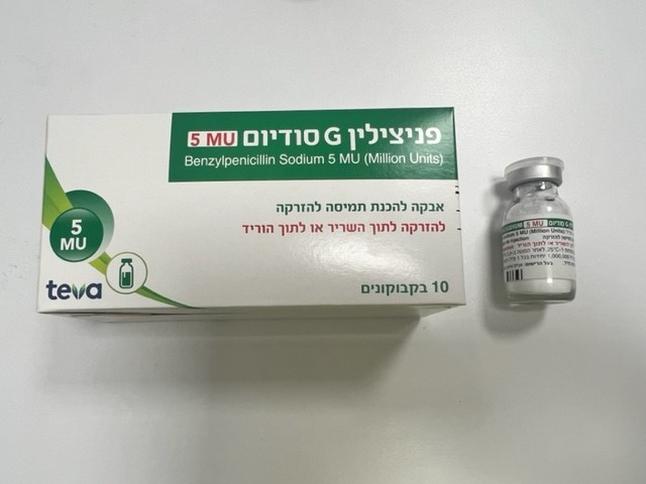Quest for the right Drug

פניצילין G סודיום 5 MU PENICILLIN G SODIUM 5 MU (BENZYLPENICILLIN SODIUM)
תרופה במרשם
תרופה בסל
נרקוטיקה
ציטוטוקסיקה
צורת מתן:
תוך-שרירי, תוך-ורידי : I.M, I.V
צורת מינון:
אבקה להכנת תמיסה לזריקה : POWDER FOR SOLUTION FOR INJECTION
עלון לרופא
מינוניםPosology התוויות
Indications תופעות לוואי
Adverse reactions התוויות נגד
Contraindications אינטראקציות
Interactions מינון יתר
Overdose הריון/הנקה
Pregnancy & Lactation אוכלוסיות מיוחדות
Special populations תכונות פרמקולוגיות
Pharmacological properties מידע רוקחי
Pharmaceutical particulars אזהרת שימוש
Special Warning עלון לרופא
Physicians Leaflet
Interactions : אינטראקציות
4.5. Interaction with other medicinal products and other forms of interaction Concomitant administration of Penicillin G -Sodium is not recommended with: Based on the general principle not to combine bactericidal and bacteriostatic antibiotics, Penicillin G-Sodium should not be combined with bacteriostatic antibiotics. Mixed injections or infusions: To avoid undesirable chemical reactions, administration of mixed injections or infusions or of admixtures with solutions that contain carbohydrates such as glucose, should be avoided (see section 6.2). Caution is required when co-administering with: Probenecid: Administration of probenecid leads to an inhibition of the tubular secretion of benzylpenicillin, resulting in an increase in serum concentration and prolongation of the elimination half-life. Furthermore probenecid inhibits the penicillin transport from the cerebrospinal fluid, so that the concomitant administration of probenecid reduces the penetration of benzyl penicillin into brain tissue even further. , Anti-inflammatories, antirheumatics and antipyretics: When co- administering Penicillin G- Sodium with anti-inflammatories, antirheumatics or antipyretics: (especially indomethacin, phenylbutazone, salicylates at high doses), it should be pointed out that excretion is competitively inhibited , resulting in an increase in serum concentration and prolongation of the elimination half-life. Digoxin: In patients treated on digoxin treatment, Penicillin G-Sodium should only be used with caution, as there is a risk of bradycardia as a result of interactions. Methotrexate: When taken at the same time as Penicillin G-Sodium, the excretion of methotrexate is reduced. This can lead to increased methotrexate toxicity. Concomitant use of methotrexate and penicillin should be avoided if possible. If concomitant use is unavoidable, a reduction in the methotrexate dose should be considered and methotrexate serum levels should be monitored. The patient should be monitored for possible additional adverse reactions of methotrexate, including leukopenia, thrombocytopenia and skin suppuration. Oral anticoagulants: Oral anticoagulants and penicillin antibiotics have been used extensively in practice without interactions. However, in the literature there are reports of an increased number of patients who experienced a bleeding event when they were prescribed acenocoumarol or warfarin at the same time as penicillin. If concomitant use is required, the prothrombin time or other suitable coagulation parameters should be carefully monitored upon co- administration or discontinuation of penicillin. Furthermore, an adjustment of the oral anticoagulant dose may be necessary (see sections 4.4 and 4.8). Synergism between antibiotics: Penicillin G-Sodium should only be given in combination with other antibiotics if a synergistic or at least an additive effect is anticipated. In general, the individual components of a combination must be given at the full effective dose. (exception if synergism is proven, the dose of the more toxic combination partner can be reduced). If duly indicated, it should, in particular, be remembered that Penicillin G-Sodium can be combined with the following bactericidal antibiotics: — Isoxazolyl penicillins (e.g. flucloxacillin and other narrow-spectrum beta lactams) — aminopenicillins — aminoglycosides The above-mentioned penicillins are given by slow intravenous injection prior to the Penicillin G-Sodium infusion. Wherever possible, aminoglycosides should be given separately via the intramuscular route.

שימוש לפי פנקס קופ''ח כללית 1994
לא צוין
תאריך הכללה מקורי בסל
01/01/1995
הגבלות
תרופה שאושרה לשימוש כללי בקופ'ח
מידע נוסף
עלון מידע לצרכן
07.08.22 - עלון לצרכן עברית 14.11.22 - עלון לצרכן אנגלית 14.11.22 - עלון לצרכן עברית 14.11.22 - עלון לצרכן ערבית 08.06.23 - עלון לצרכן עברית 24.08.23 - עלון לצרכן אנגלית 24.08.23 - עלון לצרכן עברית 24.08.23 - עלון לצרכן ערבית 09.10.12 - החמרה לעלון 01.03.20 - החמרה לעלון 20.04.21 - החמרה לעלון 25.04.21 - החמרה לעלון 07.08.22 - החמרה לעלון 08.06.23 - החמרה לעלוןלתרופה במאגר משרד הבריאות
פניצילין G סודיום 5 MU